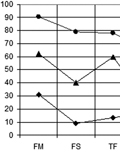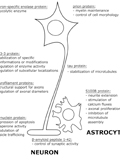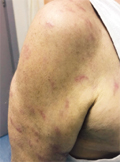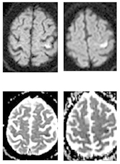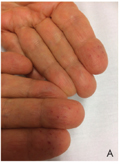The eLitMed.hu medical portal uses computer cookies for convenient operation. Detailed information can be found in the Cookie-policy.
Clinical Neuroscience - 2019;72(01-02)
Content
[Selection of the optimal device-aided therapy in Parkinson’s disease]
[For the treatment of advanced Parkinson’s disease the deep brain stimulation (DBS) and the levodopa/carbidopa intestinal gel (LCIG) therapies are available in Hungary. Although they may have similar impact on the health-related quality of life and disabilities associated with the disease, they have different indications, and inclusion- and exclusion criteria. Consequently, the patient population treated with DBS and LCIG may be different. In the present review, the authors try to help the process of selection of the optimal device-aided therapy for the patients with advanced Parkinson’s disease. ]
[Tension type headache and its treatment possibilities]
[Tension type headache, the most common type of primary headaches, affects approximately 80% of the population. Mainly because of its high prevalence, the socio-economic consequences of tension type headache are significant. The pain in tension type headache is usually bilateral, mild to moderate, is of a pressing or tightening quality, and is not accompanied by other symptoms. Patients with frequent or daily occurrence of tension type headache may experience significant distress because of the condition. The two main therapeutic avenues of tension type headache are acute and prophylactic treatment. Simple or combined analgesics are the mainstay of acute treatment. Prophylactic treatment is needed in case of attacks that are frequent and/or difficult to treat. The first drugs of choice as preventatives of tension type headache are tricyclic antidepressants, with a special focus on amitriptyline, the efficacy of which having been documented in multiple double-blind, placebo-controlled studies. Among other antidepressants, the efficacy of mirtazapine and venlafaxine has been documented. There is weaker evidence about the efficacy of gabapentine, topiramate, and tizanidin. Non-pharmacological prophylactic methods of tension type headache with a documented efficacy include certain types of psychotherapy and acupuncture. ]
[The effect of palliative neural therapy on the improvement of chronic pain]
[Objective - To assess the extent to which pain therapy can improve chronic pain in a heterogeneous group of patients, its impact on their quality of life and the correlation of the changes with their age and the underlying disease. The investigation has its actuality by its impact on public health. Methods - a prospective, non-randomized, interventional, clinical cohort study was conducted under real-life conditions in a general pain clinic, which lasted for 6 months. Changes in pain intensity (VAS) and related quality of life changes (SF-36 HRQoL) were measured using validated internationally accepted questionnaires. The questionnaires were filled out by all patients on their own, so they provided information of self-esteem on their own. All patient post-treatment results were compared to pre-treatment results. The general quality of life changes found in our patients were compared to the representative norms of healthy population in Hungary. Subjects - patients participated voluntarily at their own decision in the survey. The underlying disease of chronic pain, age and gender of the patients did not limit the inclusion into the study. Results - Data of 231 patients were evaluated. After pain therapy, the decrease in intensity of pain was confirmed by VAS at p=0.002. This was linked to a quality of life change that has been shown to be p=0.003 for men, with p=0.002 in women with SF-36 HRQoL. Based on the correlation coefficients, the changes in quality of life improved regardless of the age of the patients and the nature of the underlying conditions causing the pain. Conclusions - Although analgesia is basicly a symptomatic therapy, our findings suggest that the reduction of pain improves the quality of life of patients independently from their, and the curability of the underlying and accompanying diseases. ]
Evaluation of neutrophil-to-lymphocyte ratio and platelet-to-lymphocyte ratio in essential tremor
Introduction - Although essential tremor (ET) is the most common cause of tremor, the pathology and underlying mechanisms have not fully understood yet. In addition to kinetic tremor, patients may present several types of tremor, gait ataxia, hearing deficits and eye movement abnormalities. Non-motor symptoms and signs have also added to definition of ET. There is significant evidence indicating the neurodegenerative nature of the disease. New studies indicate that inflammation may have a place in the etiology. The neutrophil-to lymphocyte ratio (NLR) and the platelet-to lymphocyte ratio (PLR) have recently begun to be used as a marker of systemic inflammation. Our study aims at finding a clue for systemic inflammation in ET. Methods - 67 patients with ET and 40 healthy controls were recruited for the study. The total white blood cells (WBC), absolute neutrophil count, lymphocyte count and platelet count were retrieved. The NLR was calculated by dividing the neutrophil count by the lymphocyte count and the PLR was calculated by dividing the platelet count by the lymphocyte count. Results - Patient and control groups were similar in terms of age and gender. The mean age of patient group was 25.29 ± 8.24 years and that of control group was 26.77 ± 6.73 years. The NLRs were 1.85 ± 0.58 in the patient group and 1.96 ± 0.53 in the control group. For the patient group and the control group the PLRs were 103.52 ±32.80 and 91.26 ± 31.57 respectively. There were no statistically significant differences between the participants for both NLR and PLR. Conclusion - The pathophysiological mechanism for essential tremor (ET) remains unclear. However, there is an increasing amount of research being conducted on the subject. Discussions about ET’s definition as a neurodegenerative disease are ongoing. Although previous studies showed that neuroinflammation could be a part of etiology of disease, this study has failed to demonstrate systemic inflammation in ET.
Additional value of tau protein measurement in the diagnosis of Creutzfeldt-Jakob disease
Since the definite diagnosis of Creutzfeldt-Jakob disease (CJD) can currently only be provided by autopsy, there is a special need for fine diagnostic tools in live patients to achieve accurate diagnosis as early as possible. The aim of this study was to perform a preliminary retrospective analysis on the utility of the measurement of total Tau (tTau) and some other biomarkers from the cerebrospinal fluid (CSF) of patients with rapidly progressive dementia in the diagnostic work up of CJD. Beside the assessment of relevant clinical data and the findings of electroencephalography and brain magnetic resonance imaging, the presence of 14-3-3 protein and the levels of tTau were determined by Western blot technique and enzyme-linked immunosorbent assay from the CSF of 19 patients diagnosed with rapidly progressive dementia between the period of 2004-2017 at the Department of Neurology, University of Szeged. This preliminary study provided 100% sensitivity for 14-3-3, and interestingly, only 40% specificity to support the clinical diagnosis of CJD. Regarding tTau, the sensitivity values were calculated to be 100% or 83%, whereas the specificity values were 71% or 86%, depending on the applied cut-off levels. The poor specificity of 14-3-3 is not in line with literature data and may be the result of the small number of patients in the cohort with non-prion disease, predominantly consisting of disorders with considerable tissue damage, whereas tTau presented good sensitivity and specificity values. The combined application of these and novel chemical biomarkers may increase both sensitivity and specificity to a desired level.
Evaluation of body image perception in multiple sclerosis patients without neurological deficit
Objective - There is a lack of research on the association between body image perception (BIP) and multiple sclerosis (MS). The aim of this study was to evaluate BIP in MS patients and its correlation with depression, anxiety, duration of the disease, and sociodemographic characteristics of the patients. Methods - Fifty patients with MS who applied to our outpatient clinic were examined. Forty-five healthy control were recruited for the study. All patients were diagnosed with MS according to 2010 revisions of McDonald criteria. Expanded Disability Status Scale (EDSS) was performed by the same neurologist for all patients. The participants were asked to complete a sociodemographic form, Body Cathexis Scale (BCS), Beck Depression Inventory (BDI), and Beck Anxiety Inventory (BAI). Results - The mean BCS score was 86.54 ± 32.24 in MS patients and 155.00 ± 20.90 in the healthy subjects (p<0.001). While MS patients had significantly higher anxiety levels, depression scores were similar in both groups. The mean BAI score was 18.50 ± 14.03 for MS patients and 10.06 ± 7.96 in the control group (p=0.001). The BDI score of the patients was 13.77 ± 11.61 and 11.91 ± 8.65 for the controls (p=0.34). Early age of the disease onset, increased number of attacks, increased depressive symptoms, and higher anxiety levels were significantly correlated with higher BCS scores. Age and being single/ divorced/ widowed were also correlated with BCS scores. Conclusions - It is important to preserve the mental well-being of patients. Even in apparently healthy patients, the body perception may be severely impaired.
Axillary mononeuropathy after herpes zoster infection misdiagnosed as neuropathic pain
Zoster-associated extremity paresis is a rare complication of herpes zoster (HZ) and is usually due to zoster-associated mononeuropathy. Complaints of a 77-year-old man started with pain in his right arm and 4 days later he developed itchy red HZ lesions in the same area. One week later, the patient developed weakness in his right arm. The patient was diagnosed with isolated axillary mononeuropathy by physical examination and electromyography. Here, we present a case of axillary mononeuropathy which is a rare complication of HZ infection and needs particular attention.
Is isolated hand weakness associated with subtypes of stroke?
Background and aim - Isolated hand weakness is an uncommon condition in stroke patients. It is frequently confused with peripheral nerve system (PNS) pathologies; misdiagnosis may delay identification of the etiology and treatment of stroke. Herein, we aimed to underline the necessity of keeping the diagnosis of stroke in mind in case of patients with isolated hand weakness and to assess the etiology of stroke. Materials and methods - A total of eight patients (four females and four males), who are presented with isolated hand weakness and had acute cortical infarction documented via cranial MRI, were enrolled in the study. Demographic characteristics, physical and radiological findings of the patients, as well as the lateralization and etiology of infarction were evaluated. Results - The mean age of the patients was 61.8 ± 12 years. Isolated hand weakness was in the dominant hand in four patients. According to the etiology and clinical signs, the stroke was cardioembolic in three patients and they had predominant radial-side (thumb and index) finger weakness. Large vessel atherosclerosis was present in three patients; two patients with predominant ulnar-side (little and ring) finger weakness and one patient with uniform finger weakness; there were two patients with stroke of undetermined etiology and they had uniform finger weakness. Conclusion - Keeping stroke in mind together with PNS pathologies in case of isolated hand weakness is critical for early diagnosis and treatment of the patients. In addition, cardioembolic focus should be considered in case of predominant radial-side finger weakness, whereas particular attention should be paid to carotid artery diseases in case of predominant ulnar-side finger weakness.
[Multiple ischemic stroke in Osler-Rendu-Weber disease]
[Hereditary hemorrhagic teleangiectasia (HHT, Osler-Rendu-Weber disease) is an autosomal dominantly inherited disorder caused by the mutation of several possible genes and characterized by malformations of the arteriovenous system in multiple organs. The clinical diagnosis is based on the Curaçao criteria ((1) spontaneous, recurrent epistaxis; (2) teleangiectasias in characteristic sites (lips, oral cavity, nose, fingers); (3) visceral lesions (gastrointestinal, pulmonary, cerebral, spinal); (4) affected first degree relative). The aim of this study is to present the first genetically confirmed Hungarian case of hereditary hemorrhagic teleangiectasia with multiple ischemic strokes. Our 70-year-old woman has been suffering from severe epistaxis since her childhood and presented gastrointestinal bleeding during her adulthood as well. The characteristic skin lesions developed in the 5th decade of life. She was admitted to our department with loss of consciousness and fluctuating speech and swallowing problems. MRI of the brain supplemented with angiography revealed multiple arteriovenous malformations and multiple subacute ischemic lesions. The EEG demonstrated slowing of electric activity in the left frontal lobe. The neuropsychological assessment showed deficits in anterograde memory and executive functions. The diagnostic work-up for other characteristic alterations identified an arteriovenous malformation in the left lung. The genetic analysis demonstrated a heterozygous mutation in the 7th exon of the ENG gene at position 834 resulting in a thymine duplication and an early stop codon by a frame shift. The present case is largely similar to those already described in literature and draws the attention to the importance of multidisciplinary collaboration in the care of HHT patients.]
1.
Clinical Neuroscience
Is there any difference in mortality rates of atrial fibrillation detected before or after ischemic stroke?2.
Clinical Neuroscience
Factors influencing the level of stigma in Parkinson’s disease in western Turkey3.
Clinical Neuroscience
Neuropathic pain and mood disorders in earthquake survivors with peripheral nerve injuries4.
Journal of Nursing Theory and Practice
[Correlations of Sarcopenia, Frailty, Falls and Social Isolation – A Literature Review in the Light of Swedish Statistics]5.
Clinical Neuroscience
[Comparison of pain intensity measurements among patients with low-back pain]1.
2.
Clinical Neuroscience Proceedings
[A Magyar Stroke Társaság XVIII. Kongresszusa és a Magyar Neuroszonológiai Társaság XV. Konferenciája. Absztraktfüzet]3.
4.
Journal of Nursing Theory and Practice
[A selection of the entries submitted to the literary contest "Honorable mission: the joys and challenges of our profession" ]5.
Journal of Nursing Theory and Practice
[End of Life and Palliative Care of Newborns in the Nursing Context]




